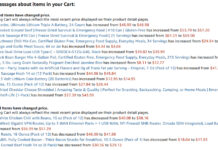This is a follow up to our last post, This is How a Collapse Starts.
I’ve talked about the coming economic and/or societal collapse before, but this time I will personalize it and tell you what my family and I are doing about it. Throughout it, I will link to prior posts on the topic so you can access more information.
Financial
I think we are more likely to experience a recession, depression, hyperinflation, or even an outright financial collapse than we are to experience civil war, a revolution or a collapse of the government, so I will address the financial component first.
Our best prep is that we are debt free have minimal bills. This didn’t happen overnight. I was 40 when I paid off my last credit card and well over 50 when we got rid of our mortgage. Getting debt free is difficult, but it can be done. Even lowering your outstanding debt is helpful.
Contrary to the World Economic Forum’s desires, we own everything and are happy. Our recurring bills are for things like insurance, electricity, phones, and Internet service. Even our taxes are low because we have a low income. One of our largest recurring expenses is grocery shopping, and we’ll cover food in the next section. But if we had to get rid of most of our expenses, we could. It wouldn’t be as comfortable, but it would be doable.
An area where I wish I was better prepared is in precious metals. I am working to set aside $1,000 to spend on pre-1965 dimes and quarters the next time I get to a gun show. If Junk Silver isn’t available, I might buy some silver Canadian Maple Leaf coins instead.
Food
Whether we see hyperinflation, where the value of your dollar changes daily or hourly, or a complete repudiation of the dollar as a mechanism for global trade, one result will be significant supply chain problems. The immediate danger will be disruptions in the food supply chain. If money stops flowing or the dollar becomes worthless, farmers will not be able to sell their produce, business won’t be able to buy, factories won’t be able to pay their workers or for their utilities, truckers won’t be able to afford fuel, and grocery stores might not know how to charge you.
Because we understand the fragile nature of our food system, we have a three prong approach: Stockpile food, grow food, barter for food with other local homesteaders and farmers.
Our stockpile is full. We top it off occasionally, but we are consuming our older food to rotate it out and buying new to replace it.
Our 11 laying hens continue to increase their output, producing an average of seven eggs per day. We expect them to average 10 per day in the summer. To ensure future egg production, we ordered eight additional chicks. They will start laying in the fall, giving us a better supply of eggs during the winter.
My wife is going full speed ahead with our garden plans. We have cut back the cover crop and then turned it over to allow it to rot in the soil, where it will add beneficial nutrients. I have 24 bags of dirt and compost on hand to top off the garden beds. (When the organic matter in the soil decays and the logs that we piled in the bottom of the beds decay, the level of soil drops, so we have to add more.)
From a barter standpoint, we hope to barter our honey and eggs for other foods.
Water
We bought this house in part because it had a gravity-fed water system that provides spring water to the house without requiring any power. In December, we buried the lines to prevent them from freezing. I was up there last week making a routine check and everything looked good. The cistern was full and water was burbling out of the overflow.
We also stock five-gallon containers of water, a couple cases of bottle water, and we have at least three streams on the property. We expect water will be the least of our worries.
Shelter
Our house is our primary shelter. It not only keeps us warm and dry, it is sufficiently remote we hope to avoid many of the problems caused by a high population density. To give you an idea of how off the beaten track we are, when some friends visited for the first time, the husband said, “so, which one of you is in the Witness Protection Program?” Others wonder how we found it. It took time. We’ve got an entire section of the blog dedicated our property search.
We live at an altitude where we don’t need air conditioning and we heat by firewood. I make it one of my primary objectives to stockpile firewood months before we need it. I have three full cords stacked on the premises. That number will double by July.
The Other Three
For communications, we have the ubiquitous Baofeng radios, some short-range walkie talkies, and a couple of world band radios in our Faraday cages. This is, admittedly, one of our weakest areas when it comes to prepping.
We have decent medical supplies, although the woman who was our group nurse recently died from a terminal illness. We have a small stockpile of drugs and antibiotics.
On the self-defense side of the equation we are well prepared, at least when it comes to small arms. The best addition would be more people. I am prepared to arm a few of our neighbors if necessary. It would be interesting to find out how many have black rifles in addition to their deer guns.
General Preps
When it comes to other preps, we have lots of “stuff.” I’m talking about things like flashlights, headlamps and batteries; screws, buts and bolts, nails, and other fasteners; chainsaw bars, chains, and oils; hand tools for gardening, carpentry, and making mechanical repairs; books on prepping, primitive living, firearm repair, gardening, preserving food; seeds, plant starter medium and peat pots; two pressure canners and a couple hundred jars; stored gasoline and kerosene; soaps, shampoos, and plenty of hygiene and paper products; and boots, socks, and spare clothing.
We also have odds and ends, like a 55-gallon plastic barrel which is intended for water storage, black plastic water pipe, and spare fence materials. I expect these and many other items could come in useful or might be valuable trade goods.
Prepping is a Journey
Maybe you aren’t this far along on your prepping journey, and that’s OK. You are probably younger, stronger, can walk further, and don’t need reading glasses to see the front sight. As we get older, we have to rely on experience and tools where strength and perseverance used to prevail. That applies to prepping and many other things.
Our home and our preps represent nigh on 30 years of prepping. You can’t expect to achieve this in five months or even five years, but you can make progress. Do what you can, when you can, and just keep moving towards the goal. When you look back, you’ll be surprised at how far you’ve come.
And if we wake up tomorrow to find the banks have all been closed to prevent withdrawals, the stock market shut down, and private jets are filling the skies as the rich and powerful bug out to their off-shore islands and 10,000 acre ranches? Just do your best with what you have. Don’t give up, stick together, and persevere. Attitude is going to be half the battle, and it can’t be found on the store shelf.







